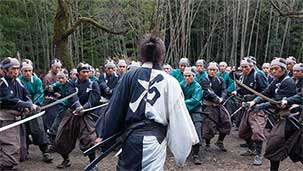It is not surprising that your film credit is located in the Art Department alongside Calligraphy and Storyboard Artist, because many of the weapons used in Blade Of The Immortal are acts of pure fiction.
That may sound like the kind of esoteric detail that concerns .0000001% of the population that go to movies (and it is) but, in this case, it also says a lot about what kind of film director Takashi Miike decided to make.
There is a great deal of history at play, given what has come before in Japanese cinema. Much of the samurai genre—most often set during the time of the Tokugawa shogunate—has been slavish in its attention to period detail. From Kurosawa to small studio efforts, most were obsessed with accurate recreations of the times and places. Even when the stories themselves echoed more contemporary themes, the physical period detail had been a central concern. Costumes, architecture, locations, farm implements, weapons, all had to be as authentic as possible. Even Miike—who justifiably has a reputation as a maverick in Japanese cinema—had followed suit in his earlier films like 13 Assassins and Hari-Kiri: Death Of A Samurai.
Blade Of The Immortal is a different animal for a couple of reasons. I won’t try to recap because it would require almost as much time as it would to watch the movie; these films are plot heavy, echoing the layered complexity of the period. In that, this is very much a typical samurai film. It is how Miike chooses to portray the physical detail of the period that is new. He rejects the conventional approach to both the weapons depicted and the way they’re deployed. In some films this would be a small detail, but here it is a major break with tradition.
There are axes that seem as if they weigh as much as ship anchors, three piece weapons that look like they were built from a demented child’s schematic, and swords that have more prongs than a 16 point buck. All are wielded to devastating effect by characters as colourful and weird as their tools—in scenes that are completely unconcerned with correct forms and accurate representations of particular martial schools.
Like most Miike films, Blade Of The Immortal doesn’t shy away from violence. However, unlike some Miike films, the depictions of the consequences of those moments are less cartoonish than usual. The contrast between the outlandish weaponry and supernatural undertones with the grim reality of the carnage gives Miike an opportunity to deal with some weighty themes—themes that would otherwise seem discordant in the midst of all the flying bodies and suddenly unmoored limbs.
The break with these traditions is itself a statement, suggesting that earlier depictions of the period were hidebound and myopic in a way that made it difficult to do anything other reiterate specific tropes. Blade Of The Immortal breaks with these traditions partly because the manga it’s adapted from did (mostly out of the artists disinterest in authenticity), and partly because it serves Miike’s intention to create something new, while clothing it in the traditions of what came before. Unlike many of its predecessors, this is a film that interests itself in distinct individuals struggling to escape what seems to be their karma, as opposed to manfully accepting their fate.
It was a surprise, and a happy one for me, to see how well you succeeded in making these outlandish weapons work within this often traditional form. It was an early announcement that this film wasn’t just going to just travel well-trodden ground, but would follow a new path. That, combined with Miike’s often puckish disregard for convention, made Blade Of The Immortal an example of something old being made new again.
Sincerely,

Tim







